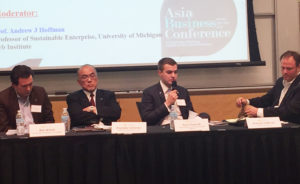I recently attended Ross Business Schools’ 25th Annual Ross Asia Business Conference January 30-31. One of the key points that I took from the Erb Institute’s panel on Energy, Innovation, and Sustainability was that thoughtful innovation can lead to major sustai nability progress.
nability progress.
Our world is enveloped in technology. Our smartphones wake us up in the morning; our email feeds provide us with immediate contact to anyone in the world; and cars and planes can transport us distances that once seemed unfathomable.
So, if the boom in technology at the turn of the 20th century began the sharp increase of carbon emissions, industrial pollution, and many of the other challenges that we face today, why not look to technology to start remediating that very process? As we strive towards the pursuit of a sustainable world, small actions taken on a large scale can result in unprecedented reductions in waste and pollution.
Take, for example, some impactful areas for carbon emission reduction through advanced technologies in:
- The commercial flight industry: Approximately 65,000 flights take off and land each day, accounting for about 2% of global carbon emissions every year. When global flights are projected to nearly double in the next 20 years, how can companies possibly decrease their carbon footprint?
- Despite the projected increase in air traffic, Boeing plans to cut their carbon emissions in half. How is this possible? With more efficient planes, efficient flights, and better fuels, this can be a reality.
- The global oil industry: One panelist explained that while the recent drop in global oil prices has seemed to set back interest in more efficient cars and environmentally conscious driving, it has allowed oil companies to invest in more sound infrastructure to increase efficiency of production and greatly reduce waste and pollution. It also has given many companies an impetus to invest in alternative forms of energy production, such as wind and solar.
- The supply chain industry: Another example comes in the form of large factories, where making a seemingly small change, such as upgrading to more efficient fans and better insulation, can equate to massive energy savings. Thoughtfully utilizing wasted space, such as rooftops of large factory complexes, for purposes like solar panels or green roofs can also go a long way in mitigating the environmental effects of those factories.
- Highlighting this point, “Industry and the Department of Energy have begun work on an energy standard for commercial and industrial fans with a preliminary estimate of as much as 8 quadrillion British Thermal Units (BTUs) in the U.S. alone,” said Tom Catania, the Erb Institute’s Executive-in-
Residence. The savings could be even bigger in Asia, considering the gargantuan factories and production centers throughout much of China, India, and Southeast Asia.
- Highlighting this point, “Industry and the Department of Energy have begun work on an energy standard for commercial and industrial fans with a preliminary estimate of as much as 8 quadrillion British Thermal Units (BTUs) in the U.S. alone,” said Tom Catania, the Erb Institute’s Executive-in-
How can the case for thoughtful technology and reduced carbon emissions be made appealing to companies and governments? The challenge is different from country to country, but overall the opportunity must be “de-risked,” according to panelists from the conference. Businesses need to see that investing in sustainable practices will pay off in the long run — not only in bottom-line profits but also in the social, environmental, and economic well being of those that companies serve.
We’re facing our current global sustainability challenges, by neglecting to critically analyze our impacts. This has resulted in inefficiencies, wasted energy, polluted air and water, and socioeconomic disparities that continue to expand.
Technology will continue to be an integral part of our lives, and if developed and used correctly, it can also begin to set us on track for a more sustainable world.